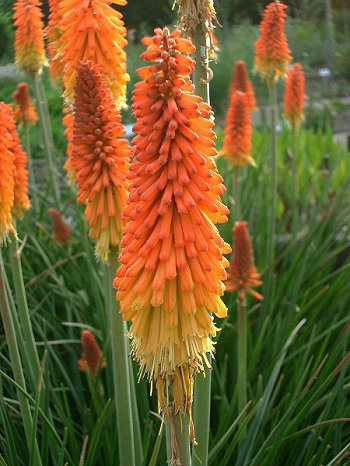
|
|
Kniphofia - Tritoma - Red hot poker
(Kniphofia uvaria)
|
Red hot poker - Kniphofia - Tritoma (Kniphofia spp.)
Kniphofia (Tritoma, Red hot poker, Torch lily, Poker plant) is a genus of plants in the family Asphodelaceae that includes 70 or more species native to Africa
and 47 of these are found in the eastern areas of South Africa..Some species have been commercially used horticulturally into many parts of the
world, such as North America, New Zealand and Europe as a garden plant and are commonly known for their bright, rocket-shaped flowers.
The genus Kniphofia is very closely related to the genus Aloe. As a result, the first Kniphofia to be d, namely K.
uvaria, was mistakenly thought to be an Aloe and was thus initially named Aloe
uvaria.
The genus Kniphofia was named in honour of Johannes Hieronymus
Kniphof, 1704-1763, who was a professor of medicine at Erfurt University in
Germany.
Most species of Kniphofia are evergreen while a few are deciduous and sprout again in the early
summer. They bear dense, erect spikes (elongated inflorescence with stalkless
flowers) above the level of the leaves in either winter or summer depending on the
species. The small, tubular flowers are produced in shades of red, orange, yellow and
cream. This gives names such as "torch" and "red hot poker" to many of
them. (K. uvaria)
Kniphofia form large clumps of arching leaves which are long, narrow and
tapering. The leaves are non-succulent, unlike the leaves of aloes. This distinguishes them from a plant such as Aloe
cooperi. The leaf surface is glabrous (smooth) in all but one species, namely, K.
hirsuta.
The underground part of the plant consists of a thick rhizome and fibrous, fleshy
roots. In some Kniphofia species the rhizome divides forming groups of stems, while in others the stems are more or less
solitary. The vast majority of Kniphofia species do not produce an aerial stem, but exceptions do occur as is the case with old specimens of K. caulescens and K. northiae which can reach a height of 30
cm.
The flowers produce copious nectar while blooming and may attract sap-suckers. Kniphofia are frequented by
nectar-feeding birds such as sunbirds and sugarbirds. They are also visited by certain
insects. The flowers of some species of Kniphofia are reportedly used as a minor food and apparently taste like
honey. K. parviflora is reported to have been made into a traditional snake
repellent. K. rooperii and K. laxiflora are used traditionally as a medicine. An infusion of the roots is used to relieve or treat the symptoms of certain chest
disorders. The rhizomes of Kniphofia foliosa are used in Ethiopia for the treatment of abdominal
cramps. The plant is also used to eradicate endoparasites in cattle. The rhizome is said to be edible
Kniphofia spp. occur naturally in all the nine provinces of South Africa.
Kwazulu-Natal possesses the highest number of Kniphofia species, compared to the other provinces with ± 40 to 50
species. Kniphofia also occurs in Lesotho, Swaziland and northward towards Sudan. The species
diversity, however, decreases as one moves north.Kniphofia foliosa is endemic to
Ethiopia.
Three species occur naturally outside continental Africa. Two of these species occur in Madagascar and one in
Yemen. Most Kniphofia species are found growing near rivers or in places where conditions will become damp or marshy for part of the
year. A small number of species prefer dry conditions with good drainage.
Source:
http://en.wikipedia.org/wiki/Kniphofia
http://en.wikipedia.org/wiki/Kniphofia_uvaria
http://www.plantzafrica.com/plantklm/kniphofias.htm
http://database.prota.org/PROTAhtml/Kniphofia%20foliosa_En.htm
